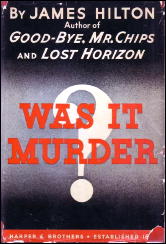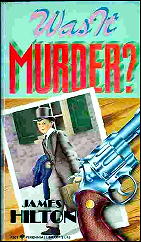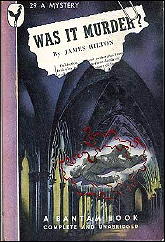Sat 24 Jul 2010
A Review by Maryell Cleary: JAMES HILTON – Was It Murder?
Posted by Steve under Authors , Bibliographies, Lists & Checklists , Crime Fiction IV , Reviews[3] Comments

JAMES HILTON – Was It Murder? Paperback reprint: Bantam #29, 1946. Hardcover edition: Harper & Brothers, US, 1933. Other reprints include: Dover, trade paperback, 1979; Perennial Library, pb, 1980. First published as Murder at School, by Glen Trevor: Benn, UK, hardcover, 1931.
James Hilton’s only mystery is set in a boys’ school in England. It is interesting to compare it with Nicholas Blake’s mystery A Question of Proof, which has the same sort of setting. Both Hilton and C. Day Lewis, Blake’s real name wrote other kinds of literature and gained their primary reputation that way.
Blake, in his first detective story, gives us the picture of an entire school and its operations, while Hilton prefers to concentrate on one segment. Hilton shows us just a corner of the physical domain: the headmaster’s house, the home of one of the married masters, a dormitory, and glimpses of the chapel and the Circle, a path around the perimeter of the school.

His amateur detective, Colin Revel, is an “old boy” of Oakington, so it is not hard to find an excuse for his presence before there is widespread suspicion of murder.
Blake’s detective is called in by a master under suspicion after murder has very obviously been done. Yet both fit well into the schools, get along with masters and boys, and don’t seem out of place.
Revell is called in by the headmaster, Dr. Robert Roseveare when one of the younger boys is killed, apparently by acc1dent. Roseveare seems nervous, but as the investigation goes on and the accident seems to be precisely that, he is quite anxious to have Revell leave.
Then a second boy dies, a brother of the first, in another ‘accident.’ Revell hastens back; the police are called in by the boys guardian, and evidence is found that this time it is murder.

Suspicion naturally falls on the master, who inherits all the boys’ wealth. But there is no evidence. And there is a deathbed confession, and the police leave. But Revell is not satisfied and stays on.
The cast of characters is small; suspicion never goes far from the one person. There is less a hunt for evidence than a delving into the high emotions of the people: love, jealousy, greed, fear, pride.
Sophisticated readers of the 70s may guess the surprise solution before the end, but the writer keeps up the drama and the suspense; we can’t be sure. And when the final revelations come, they draw together all the skeins, and one puts down the book with a sigh of satisfaction.
Bibliographical Note: It is not quite true, perhaps, that this book was Hilton’s only mystery, as there are three others listed under his name in the Revised Crime Fiction IV, by Allen J. Hubin. Two are included only marginally, however, and the third may be a crime story without being a mystery, per se. For completeness, though, here’s the complete list:
HILTON, JAMES. 1900-1954.
-Rage in Heaven (n.) King 1932
Knight Without Armour (n.) Benn 1933
Was It Murder? (n.) Harper 1933. See: Murder at School (Benn 1931), as by Glen Trevor.
-We Are Not Alone (n.) Macmillan 1937
July 24th, 2010 at 8:40 pm
RAGE IN HEAVEN, which was a film with Ingrid Bergman, Robert Montgomery, George Sanders, and Oscar Homolka, is close to a straight suspense novel in some ways. A wealthy but mentally disturbed man drives his wife into the arms of his best friend and then kills himself framing his friend for murder and the wife and a psychiatrist race to clear the friend before he is hanged.
Of course it is written in a more novelistic style than a suspense or mystery novel.
For once Sanders was the innocent friend and not the killer.
KNIGHT WITHOUT ARMOUR or WITHOUT ARMOUR is a spy story about a deep cover British agent in Revolutionary Russia saving and romancing a beautiful aristocrat. If you can find it see the great film with Robert Donat and Marlene Dietrich from the Korda’s.
WE ARE NOT ALONE is vaguely Gothic in the Jane Eyre sense about a doctor who falls in love with the governess causing problems with his shrewish wife. The book was a parable about the coming war. The film starred Paul Muni.
July 24th, 2010 at 9:30 pm
RAGE IN HEAVEN is known as movie that Robert Montgomery notoriously did not want to be in, and essentially sabotaged the production by refusing any direction whatsoever.
If all I’ve read about the movie is true.
And if so, I don’t think it did his career any good, either. He’s not remembered much today.
July 24th, 2010 at 10:34 pm
Save for film noir fans Montgomery is probably better remembered today for his daughter Elizabeth and writing speeches for President Eisenhower.
But for film noir fans there is always his performances and direction in RIDE THE PINK HORSE and LADY IN THE LAKE.
A RAGE IN HEAVEN was forced on him in hopes playing another madman would repeat his success (and the box office) for his tour-de-force performance in Emilyn William’s NIGHT MUST FALL.
And of course, since someone is bound to mention it, he was Lord Peter Wimsey though very miscast, in HAUNTED HONEYMOON, and outstanding in Philip MacDonald’s THE MYSTERY OF MR. X.
One of his best roles was as Brick in John Ford’s THEY WERE EXPENDABLE where he and John Wayne played P.T. boat commanders during the early days of WW II in the Pacific echoing Montgomery’s own service commanding a P.T. boat during the war.